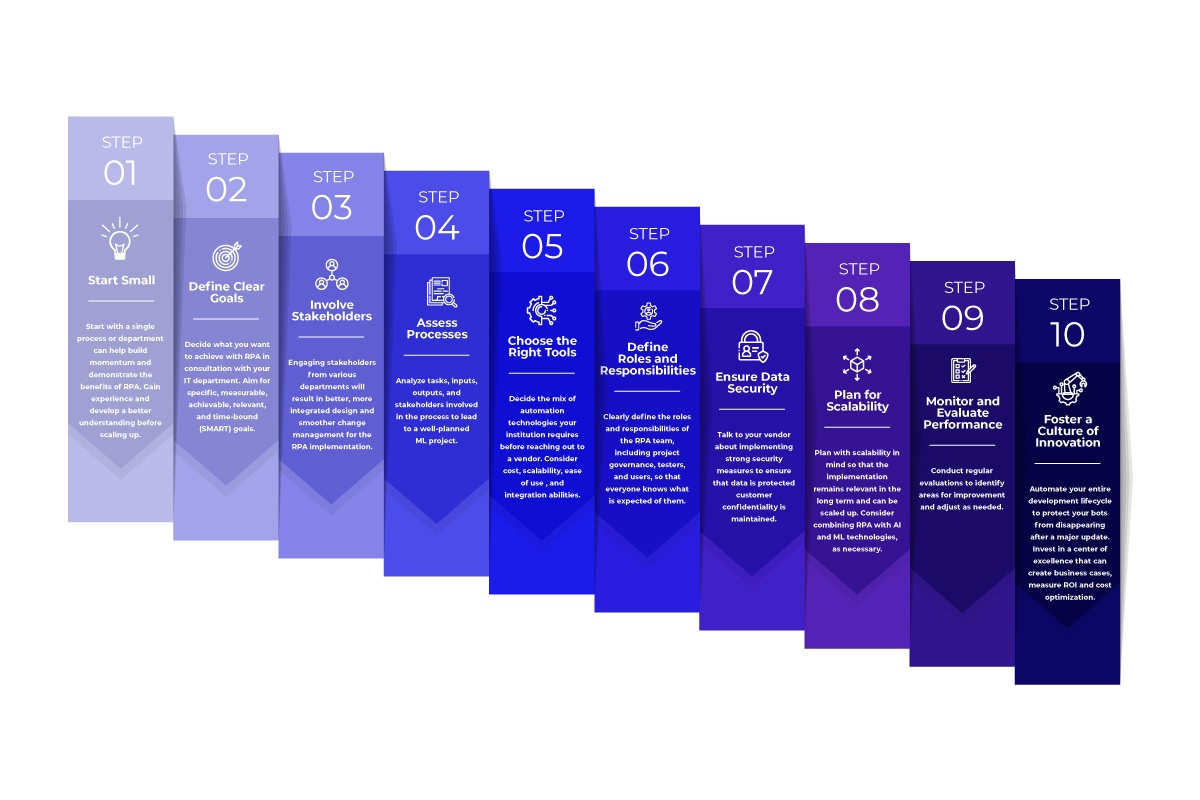
Automation has taken the finance industry by storm, and for all good reasons. Banking automation technologies like Robotic Process Automation (RPA) come with the promise of streamlining processes and increasing efficiency.
According to Forbes, RPA has the potential to transform the way finance functions, from reducing manual errors to freeing up valuable resources. To help you maximize the benefits of RPA in finance, we’ve put together a list of 10 tips for successful implementation. But first, let’s take a step back and explore what RPA is.
What is Robotic Process Automation (RPA)?
RPA is the use of software robots to automate routine and repetitive tasks like document processing, freeing up employees to focus on strategic activities that can lead to better customer service or innovations that could meet customer expectations.
The bots are programmed to follow specific rules and procedures to complete a task, just like an employee. They can interact with various software applications and systems, such as spreadsheets and databases, to collect and process data. The bots can also make decisions, trigger responses, and communicate with other systems and software.
When a task is triggered, the bot performs it automatically, eradicating the scope of errors that may be produced through manual processes. The process is monitored and managed by a central control system, allowing adjustments and updates to be made as needed.
Think of RPA as a digital workforce, working tirelessly in the background to complete tasks that would otherwise take hours to complete. With RPA in finance, your financial institution can increase efficiency, reduce costs, and improve the accuracy of its processes.
The Use of RPA in Banking Automation
There are many ways in which RPA can be used in banking automation. Here are some of them:
Customer Service Automation
RPA is capable of automating routine customer service tasks such as account opening, balance inquiries, and transaction processing, allowing bank employees to focus on more complex customer needs.
Loan Processing
RPA in banking and finance can streamline the loan processing workflow by automating repetitive tasks such as document collection and verification, credit score analysis, and loan decision-making.
Fraud Detection and Prevention
In 2022 alone, banks and financial institutions lost $500K to fraud. Technologies like RPA can analyze vast amounts of data to detect and prevent fraud in real-time, improving the accuracy and speed of fraud detection. It may also report any suspected fraud to the banking authorities as soon as it is discovered.
KYC and AML Compliance
Verification and compliance document processing can eat up a major share of your institution’s resources. RPA can automate the process of collecting, verifying, and analyzing customer information, helping banks to comply with KYC (Know Your Customer) and AML (Anti-Money Laundering) regulations.
Back Office Operations
RPA can automate various back-office tasks such as data entry, reconciliation, report generation, monthly closing, and management reports, freeing up employees to focus on more strategic initiatives.
Payment Processing
Manual data entry in payment processing can lead to manual errors and longer processing time. RPA can automate the payment processing workflow, including payment initiation, authorization, and settlement, reducing the risk of errors and improving efficiency.
Risk Management
Banks and financial institutions are constantly at risk from various sources. RPA in finance can help institutions identify, assess, and manage risks by automating data collection, analysis, and reporting, improving the accuracy and speed of risk assessments.
Internal Compliance Monitoring
RPA can automate the process of monitoring and reporting on compliance with internal policies and regulations, reducing the risk of non-compliance and improving overall compliance management.
The potential of RPA in banking and finance is unlimited. When combined with Intelligent Automation technologies, RPA can leverage Artificial Intelligence (AI) and Machine Learning (ML) to provide more intelligent process automation. While the technology in itself is efficient, financial institutions must know how to implement it for maximized benefit.
10 Tips for Successfully Implementing RPA in Finance
According to the Deloitte Global RPA survey, 53% of organizations who took part in the survey have already begun their RPA implementation. The number is expected to rise to 72% over the next year. Entering the RPA race can be quick, but managing and scaling it is a different ball game. Before getting started with automation initiatives, it is important to consider the following tips.
Start Small
While RPA might seem useful to rejuvenate all of your systems and processing, it is important to consider the business impact and start small. Beginning with a smaller project, for example, a single process or department can help build momentum and demonstrate the benefits of RPA. It also allows the organization to gain experience and develop a better understanding of the technology before scaling up.
Define Clear Goals
The key to successful RPA implementation rests in your goals. Decide what you want to achieve with RPA in consultation with your IT department. Having a clear understanding of the goals and objectives of the RPA implementation will ensure that resources are allocated appropriately and that the project stays on track. Aim for specific, measurable, achievable, relevant, and time-bound (SMART) goals.
Involve Stakeholders
Engaging stakeholders, such as the management, finance employees, and IT, can help build better design and smoother change management for the RPA implementation. It also ensures that the RPA system is well-integrated across departments and addresses the needs and concerns of all stakeholders.
Assess Processes
When a financial institution leverages too many bots to automate processes, it results in a pile of data. They may be tempted to use ML on the data and create a chatbot to make customer queries easier. However, it can lead to a poorly planned ML project. Thus, a thorough assessment of the processes is critical to ensure that the RPA implementation does not get sidetracked. This assessment should include an analysis of the tasks, inputs, outputs, and stakeholders involved in the process.

Choose the Right Tools
Selecting the right RPA tools and technology is critical to the success of the implementation. Decide the mix of automation technologies your institution requires before reaching out to a vendor. Factors to consider include the cost, scalability, and ease of use , as well as its ability to integrate with other systems and applications.
Define Roles and Responsibilities
Clearly defining the roles and responsibilities of the RPA team, including project governance, testers, and users, is important to ensure that everyone knows what is expected of them. Remember that automation is a gradual process, and your employees will still need to interfere if it is not properly automated.
Ensure Data Security
Protecting sensitive data and customer information is a key concern in finance. RPA needs to be implemented in such a way that data security remains unaffected. Discuss with your vendor about strong security measures to ensure that data is protected and that the confidentiality of customer information is maintained.
Plan for Scalability
There are thousands of processes in banks and financial institutions that can use automation. Thus, the RPA implementation should be planned with scalability in mind so that the technology and processes can be scaled up as needed. This helps to ensure that the RPA can be combined with AI and ML technologies as necessary and the implementation remains relevant in the long term.
Monitor and Evaluate Performance
Continuously monitoring and evaluating the performance of the RPA bots is critical to ensure that they are operating effectively and efficiently. Also, do not forget to keep HR in the loop so that employees are informed and trained about the changing processes and how to use them in a timely manner. Regular evaluations should be conducted to identify areas for improvement and to make adjustments as needed.
Foster a Culture of Innovation
Encouraging a culture of innovation and experimentation can help to ensure that the organization is prepared for the future. Consult your IT department and automate your entire development lifecycle to protect your bots from disappearing after a major update. Invest in a center of excellence that can create business cases, measure ROI and cost optimization and track progress against goals.
Implementation Automation with Blanc Labs
At Blanc Labs, we understand that every financial and banking institution has unique needs and challenges when it comes to RPA implementation. That’s why we offer tailor-made RPA solutions to ensure seamless implementation for our clients.
Our RPA systems are designed to be flexible and scalable, allowing our clients to start small and grow as needed. We provide end-to-end support, from process assessment and design to implementation and ongoing assistance, to ensure that our clients realize the full benefits of RPA.
Booking a free consultation with us is the first step toward successful RPA implementation. Our team of experts work closely with each client to understand their specific requirements and goals to build a customized RPA solution to meet their needs.